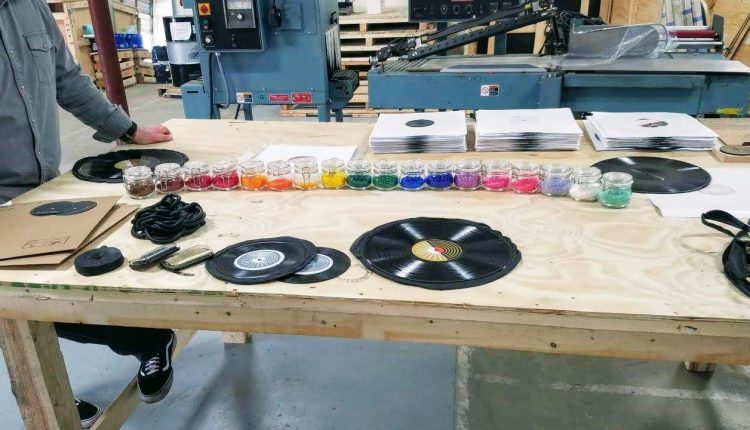
Site Visit: Plant Spins Regulatory Concerns Round and Round with Advocacy
By Zvi Rosen, Assistant Chief Counsel
On March 22, Michael McManus, Zvi Rosen, and Rosalyn Steward from the Office of Advocacy visited Gold Rush Vinyl, a brand-new pressing plant for vinyl records in Austin, Texas. The visit was facilitated by the Texas Music Office, and Marc Fort and several others from the Texas Music Office were on hand, as well.
Gold Rush Vinyl is owned by its founder, Caren Kelleher, whose CV includes working for Google, managing bands, and a Harvard MBA. She was inspired to found the company after being unable to get copies of LPs for bands she managed in time for shows, and realizing that there was a market niche for a record company to do smaller LP orders on a quick turnaround, using new technology instead of the clunkier record presses of yore. Kelleher worked with the SBA and used SBA loans to finance the creation of her dream business – Gold Rush Vinyl.
Kelleher’s previous experience with Google handling music licensing is critical for Gold Rush, which allows it to navigate the rules regarding music licensing and copyright law for a wholesale record press. The computerized record presses are purchased from Canada, and their software is governed by international copyright and trade secret laws. In addition, Gold Rush faces all the usual regulatory concerns of a small business in manufacturing, including worker safety rules, even as the computerized machines make the process than it has ever been before.
Despite any regulatory concerns Kelleher and her associates have, her business is filling a void for nostalgic music fans as well as letting a new generation appreciate the sound of a record. Lots of audiophiles say that when it comes to sound quality, nothing beats vinyl. Kelleher told the Austin American-Statesman that her company is going to focus on smaller orders for independent artists.
By the mid-2000’s, vinyl records were at a low, and the music business was weathering the crisis of Napster and file sharing more generally. However, a bright light would begin to appear for the business – people began buying vinyl records again, after the format had been left for dead over a decade earlier. At first existing used stocks were sufficient, but people wanted to hear more than just old recordings on their new record players, and new vinyl pressings were needed. 2017 marked a 12th straight year of growth in vinyl record sales, and the sky seems to be the limit. At first these pressing plants used vinyl presses which had been mothballed decades earlier, and increasingly entrepreneurs went looking for used vinyl presses, paying higher and higher prices for it. However, such machinery inevitably was not made for the digital era, and lacked efficiencies that a vinyl press designed from the ground up today would have. A Canadian company began designing such a computerized vinyl press, and Gold Rush is using two of their machines to press records, allowing them to press different records much more efficiently and with lower costs than they would have using secondhand older presses.
However, the first parts of making a record haven’t changed in decades – you start with vinyl. The vinyl is shaped from pellets into a “donut” and a label is prepared. Different colors can also be added to give the vinyl a different look – a solid color, swirls, or other patterns. The label is placed atop the vinyl, which is pressed, quickly heated, and just as quickly cooled, settling into its finished shape. The shape is created by electroplating a “master” with the negative image of the record, and then a having that electroplated master pressed into the vinyl. Gold Rush does not create these electroplated masters in house, due to the complexity of the chemical procedure as well as environmental regulations concerning waste from electroplating, and instead use an outside contractor.
The key parts of making a record are actually steam (to heat the vinyl so it forms completely) and cold water (to quickly re-cool the vinyl so it takes the exactly shape needed). Accordingly, Gold Rush Vinyl relies on a complicated series of processes to automate provision of steam and cold water, using proprietary processes that are kept secret. The computerized presses only require one operator, everything else is handled by robotic arms and the device’s software.
It is that kind of precision and care that may help Kelleher’s company strike that Gold record from her 8,400-square-foot warehouse in the live music capital of the world.
Advocacy was in San Antonio and Houston, Texas for Regional Regulatory Reform Roundtable and NAFTA Modernization Outreach Meetings on March 19-20.
Can’t get to a roundtable near you? Fill out this form and tell us about your federal regulatory burdens. We will pass this information on to the appropriate agency and use it in the planning of upcoming Regional Regulatory Reform Roundtables.
Zvi Rosen is an Assistant Chief Counsel for Advocacy whose portfolio includes intellectual property. Rosen can be reached at zvi.rosen@sba.gov.
Related:
Site Visit: Houston has a Regulatory Problem that Advocacy Aims to Solve
By David Rostker, Assistant Chief Counsel
Federal Procurement, NAFTA, and Agricultural Issues Highlight San Antonio Roundtable
By Bruce Lundegren, Assistant Chief Counsel
“Stop the Madness and Fix the Mess!”
Texas Small Businesses Plead for Regulatory Relief
By Claudia Rodgers, Senior Counsel
Site Visit: Museum Brings Offshore Oil Industry Concerns Ashore
By Prianka Sharma, Assistant Chief Counsel
Site Visit: Small Business Brings Sizzling Regulatory Concerns to the Table
By Nick Ivory, Regional Legislative and Regulatory Manager
Site Visit: Advocacy Staff Learns About Role of NAFTA during Visit with Owners of Concord Supply
By Lindsay Abate, Regulatory Economist
